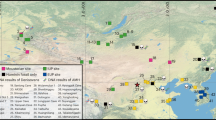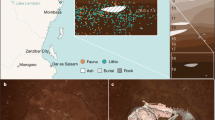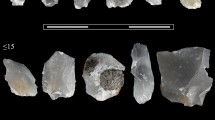Abstract
Over 60 years ago, stone tools and remains of megafauna were discovered on the Southeast Asian islands of Flores, Sulawesi and Luzon, and a Middle Pleistocene colonization by Homo erectus was initially proposed to have occurred on these islands1,2,3,4. However, until the discovery of Homo floresiensis in 2003, claims of the presence of archaic hominins on Wallacean islands were hypothetical owing to the absence of in situ fossils and/or stone artefacts that were excavated from well-documented stratigraphic contexts, or because secure numerical dating methods of these sites were lacking. As a consequence, these claims were generally treated with scepticism5. Here we describe the results of recent excavations at Kalinga in the Cagayan Valley of northern Luzon in the Philippines that have yielded 57 stone tools associated with an almost-complete disarticulated skeleton of Rhinoceros philippinensis, which shows clear signs of butchery, together with other fossil fauna remains attributed to stegodon, Philippine brown deer, freshwater turtle and monitor lizard. All finds originate from a clay-rich bone bed that was dated to between 777 and 631 thousand years ago using electron-spin resonance methods that were applied to tooth enamel and fluvial quartz. This evidence pushes back the proven period of colonization6 of the Philippines by hundreds of thousands of years, and furthermore suggests that early overseas dispersal in Island South East Asia by premodern hominins took place several times during the Early and Middle Pleistocene stages1,2,3,4. The Philippines therefore may have had a central role in southward movements into Wallacea, not only of Pleistocene megafauna7, but also of archaic hominins.
This is a preview of subscription content, access via your institution
Access options
Access Nature and 54 other Nature Portfolio journals
Get Nature+, our best-value online-access subscription
$29.99 / 30 days
cancel any time
Subscribe to this journal
Receive 51 print issues and online access
$199.00 per year
only $3.90 per issue
Buy this article
- Purchase on Springer Link
- Instant access to full article PDF
Prices may be subject to local taxes which are calculated during checkout



Similar content being viewed by others
References
Van Heekeren, H. R. Early man and fossil vertebrates on the island of Celebes. Nature 163, 492 (1949).
Maringer, J. & Verhoeven, T. Die steinartefakte aus der Stegodon-fossilschicht von Mengeruda auf Flores, Indonesien. Anthropos. 65, 229–247 (1970).
von Koenigswald, G. H. R. Preliminary report on a newly-discovered Stone Age culture from northern Luzon, Philippine Islands. Asian Perspect. 2, 69–70 (1958).
Fox, R. B. in Paleolithic in South and East Asia 59–85 (Mouton Publishers, The Hague, 1978).
Heaney, L. R. Zoogeographical evidence for Middle and Late Pleistocene land bridges to the Philippines islands. Mod. Quat. Res. SE Asia 9, 127–143 (1985).
Mijares, A. S. et al. New evidence for a 67,000-year-old human presence at Callao Cave, Luzon, Philippines. J. Hum. Evol. 59, 123–132 (2010).
Ingicco, T. et al. A new species of Celebochoerus (Suidae, Mammalia) from the Philippines and the paleobiogeography of the genus Celebochoerus Hooijer, 1948. Geobios 49, 285–291 (2016).
Brumm, A. et al. Hominins on Flores, Indonesia, by one million years ago. Nature 464, 748–752 (2010).
van den Bergh, G. D. et al. Homo floresiensis-like fossils from the early Middle Pleistocene of Flores. Nature 534, 245–248 (2016).
van den Bergh, G. D. et al. Earliest hominin occupation of Sulawesi, Indonesia. Nature 529, 208–211 (2016).
Dizon, E. Z. & Pawlik, A. F. The lower Palaeolithic record in the Philippines. Quat. Int. 223–224, 444–450 (2010).
Mathisen, M. & Vondra, C. The fluvial and pyroclastic deposits of the Cagayan Basin, northern Luzon, Philippines—an example of non-marine volcaniclastic sedimentation in an interarc basin. Sedimentology 30, 369–392 (1983).
Mathisen, M. E. Plio-Pleistocene geology of the Central Cagayan Valley, Northern Luzon, Philippines. PhD thesis, Iowa State Univ. (1981).
Pawlik, A. F. The Paleolithic site of Arubo 1 in Central Luzon, Philippines. Bull. Indo-Pacific Prehistory Assoc. 24, 1–10 (2004).
Yravedra, J. et al. Cut marks on the Middle Pleistocene elephant carcass of Áridos 2 (Madrid, Spain). J. Archaeol. Sci. 37, 2469–2476 (2010).
Mosquera, M. et al. Barranc de la Boella (Catalonia, Spain): an Acheulean elephant butchering site from the European late Early Pleistocene. J. Quaternary Sci. 30, 651–666 (2015).
Fernandez-Jalvo, Y. & Andrews, P. Atlas of Taphonomic Identifications (Springer, Dordrecht, 2016).
Voinchet, P. et al. ESR dating of quartz extracted from Quaternary sediments: Application to fluvial terraces system of Northern France. Quaternaire 15, 135–141 (2004).
Lee, M.-Y., Chen, C.-H., Wei, K.-Y., Iizuka, Y. & Carey, S. First Toba supereruption revival. Geology 32, 61–64 (2004).
Valet, J.-P. et al. Geomagnetic, cosmogenic and climatic changes across the last geomagnetic reversal from equatorial Indian Ocean sediments. Earth Planet. Sci. Lett. 397, 67–79 (2014).
Liu, W. et al. The earliest unequivocally modern humans in southern China. Nature 526, 696–699 (2015).
Wang, P., Li, Q. (eds). The South China Sea: Paleoceanography and Sedimentology Vol.13, 25–73 (Springer, Dordrecht, 2009).
Voris, H. K. Maps of Pleistocene sea levels in Southeast Asia: shorelines, river systems and time durations. J. Biogeogr. 27, 1153–1167 (2000).
Détroit, F., Corny, J., Dizon, E. Z. & Mijares, A. S. “Small size” in the Philippine human fossil record: is it meaningful for a better understanding of the evolutionary history of the negritos? Hum. Biol. 85, 45–66 (2013).
Sutikna, T. et al. Revised stratigraphy and chronology for Homo floresiensis at Liang Bua in Indonesia. Nature 532, 366–369 (2016).
Brumm, A. et al. Age and context of the oldest known hominin fossils from Flores. Nature 534, 249–253 (2016).
Cooper, A. & Stringer, C. B. Did the Denisovans cross Wallace’s Line? Science 342, 321–323 (2013).
Ruxton, G. D. & Wilkinson, D. M. Population trajectories for accidental versus planned colonisation of islands. J. Hum. Evol. 63, 507–511 (2012).
Erlandson, J. M. & Fitzpatrick, S. M. Oceans, islands, and coasts: current perspectives on the role of the sea in human prehistory. J. Island Coast. Archaeol. 1, 5–32 (2010).
Dennell, R. W., Louys, J., O’Regan, H. J. & Wilkinson, D. M. The origins and persistence of Homo floresiensis on Flores: biogeographical and ecological perspectives. Quat. Sci. Rev. 96, 98–107 (2014).
Duval, M. & Grün, R. Are published ESR dose assessments on fossil tooth enamel reliable? Quat. Geochronol. 31, 19–27 (2016).
Koeberl, C. The geochemistry of tektites: an overview. Tectonophysics 171, 405–422 (1990).
De Vos, J., Sartono, S., Hardja-Sasmita, S. & Sondar, P.-Y. The fauna from Trinil, type locality of Homo erectus a reinterpretation. Geologie Mijnbouw 61, 207–211 (1982).
van den Bergh, G. D. et al. Homo floresiensis-like fossils from the early Middle Pleistocene of Flores. Nature 534, 245–248 (2016).
van den Bergh, G. D., de Vos, J. & Sondaar, P. Y. The Late Quaternary palaeogeography of mammal evolution in the Indonesian Archipelago. Palaeogeogr. Palaeoclimatol. Palaeoecol. 171, 385–408 (2001).
Downing, K. F., Musser, G. G. & Park, L. E. in Advances in Vertebrate Paleontology and Geochronology Vol. 14 (eds Tomida, Y. et al.) 105–121 (National Science Museum Monographs, Tokyo, 1998).
Bahain, J.-J., Yokoyama, Y., Falguères, C. & Sarcia, M. N. ESR dating of tooth enamel: a comparison with K–Ar dating. Quat. Sci. Rev. 11, 245–250 (1992).
Grün, R. & Katzenberger-Apel, O. An alpha irradiator for ESR dating. Anc. TL 12, 35–38 (1994).
Brennan, B. J., Rink, W. J., McGuirl, E. L., Schwarcz, H. P. & Prestwich, W. V. Beta doses in tooth enamel by “one-group” theory and the ROSY ESR dating software. Radiat. Meas. 27, 307–314 (1997).
Prescott, J. R. & Hutton, J. T. Cosmic ray contributions to dose rates for luminescence and ESR dating: large depths and long-term time. Radiat. Meas. 23, 497–500 (1994).
Shao, Q., Bahain, J.-J., Dolo, J.-M., Falguères, C. Monte Carlo approach to calculate US-ESR ages and their uncertainties. Quat. Geochronol. 22, 99–106 (2014).
Acknowledgements
J. Barns and A. Labrador provided support for this research as well as G. Concepcion and M. dela Cruz Jr. The Kalinga excavation project was funded by the French Department for Foreign Affairs (Project MARCHE, to T.I.), The National Museum of The Philippines (to C.J.-o. and M.C.R.), The University of the Philippines Diliman Research Grant of the Office of Vice President for Academic Affairs (to T.I.) and the European Social Fund (Project ISOLARIO, NSRF Thalis-UOA, to G.L.). T.I. also received funding from a National Geographic Global Exploration grant (HJ-035R-17), from the French Centre National de la Recherche Scientifique (GDRi PalBiodivASE with Valéry Zeitoun), from Sorbonne Universités (Project MH@SU TAPHO), from the Société des Amis du Musée de l’Homme and from the LabEx BCDiv. G.D.v.d.B. received funding from an Australian Research Council (ARC) Future fellowship (FT100100384). J.d.V. received funding from the Quaternary and Prehistory Erasmus Mundus Program. Additional funding was provided by the Embassy of France to the Philippines and by the Rizal Municipality. M.G.C. received funding from CERCA Programme/Generalitat de Catalunya. We thank S. Hayes for her feedback on the manuscript; M.-M. Blanc-Valleron for providing access to the X-ray diffractometer; A. Ledoze, S. Puaud, V. Scao, S. Baillon, H. Guillou, J. Marteau, M. Bigerelle, R. Deltombe, D. Borshneck and F. Demory for their valuable help in the laboratory analyses.
Reviewer information
Nature thanks M. Duval, J. Kappelman, R. Potts and the other anonymous reviewer(s) for their contribution to the peer review of this work.
Author information
Authors and Affiliations
Contributions
T.I., J.d.V. and A.B. conceived the study with C.J-o. and G.D.v.d.B. in collaboration with N.A., G.L., P.C.H.A. and M.L. The site stratigraphy was recorded and analysed by G.D.v.d.B. Samples for ESR/U-series dating were analysed by J.-J.B., Q.S. and C.F. Samples for ESR dating on quartz were analysed by P.V. Samples for 40Ar/39Ar dating were analysed by S.N. and A.P. D.Y. analysed samples for palaeomagnetism. P.R. analysed the tektite. The lithic material was studied by H.F. and M.G.C. Palaeobotanical remains were analysed by A.-M.S. and C.K. The faunal and taphonomical analysis was conducted by T.I., K.M., M.C.R. and N.A. T.I. and G.v.d.B. wrote the manuscript.
Corresponding authors
Ethics declarations
Competing interests
The authors declare no competing interests.
Additional information
Publisher’s note: Springer Nature remains neutral with regard to jurisdictional claims in published maps and institutional affiliations.
Extended data figures and tables
Extended Data Figure 1 Geology and sedimentology of the Kalinga Excavation site.
a, Detailed stratigraphic drawing of trench H also showing the east wall of the S quadrant of the main excavation. The sedimentary patterns are the same as in Fig. 1. Representative logarithmic grain-size diagrams are shown for samples from each sedimentary unit. b, Detailed stratigraphic drawing of the main excavation walls. c, Overview towards the northwest of the quadrants N and NW of the main excavation in 2015. The concentration of faunal remains and stone tools lying at the base of unit F is exposed, just above the eastward sloping erosional contact with unit A. d, Detailed view of quadrant NW showing the position of a flake lying next to the rhinoceros left femur. e, Detail of quadrant N showing the piece of waterlogged wood fragment (yellow outline) recovered near a rhinoceros rib extremity (blue outline). f, Detail of quadrant NE showing the tektite recovered in unit F along with the faunal and lithic remains.
Extended Data Figure 2 Faunal remains from Kalinga archaeological unit F.
a, Drawing showing the preservation of the rhinoceros and position of the taphonomical marks. A total of 97 fragments of ribs of all sizes have been recovered and not all of them could be clearly positioned on the skeleton. We estimate that about 75% of the skeleton has been recovered. b, Fibula of Varanus salvator. c, Radius of a Cervidae. d, Molar of Cervus cf. mariannus. e, Molar fragment of Stegodon cf. luzonensis.
Extended Data Figure 3 Digital elevation model of the main Kalinga excavation.
The model shows the contact surface topography between unit A and unit F and the vertical projections (black squares) of the archaeological materials (coloured points) on this surface. The model was produced by interpolation through a kriging method from 37 three-dimensional coordinates recorded in the main excavation with a total station on the erosional surface that cuts down into unit A. This surface of contact corresponds to an erosional channel cutting down into the sandy unit A. All the material has been recovered lying across the base of the clay-rich unit F along this channel, between 0.7 m and 1.3 m deep.
Extended Data Figure 4 X-ray diffraction pattern of powdered unit F clays.
Quartz corresponds to the bipyramidal quartz crystals, some of which are visible to the naked eye. Bipyramidal quartz, albite, hornblende, nontronite and saponite all have a volcanic origin. Albite is a plagioclase feldspar frequent in pegmatites. Hornblende is a common silicate mineral in igneous and metamorphic rocks. Nontronite is an iron-rich smectite type of clay, which can be produced by hydrothermal alteration. Similarly, the smectite mineral saponite results from alteration of volcanic glass. The mineral composition of unit F supports the interpretation as a mudflow set in a volcanic environment. CPS, counts per second; Cu K-α corresponds to the wavelength.
Extended Data Figure 5 40Ar/39Ar fusion ages of single potassium plagioclase crystals for samples from unit A and unit G.
a, b, Probability diagrams (a) are correlated to the related inverse isochrones (b). Individual ages in a are ±1σ.
Extended Data Figure 6 Measurements of dose rates and calculation of equivalent dose to compute the ESR ages from quartz crystals and tooth enamel.
a, Al and Ti centre ESR spectra of natural and bleached aliquots for unit A quartz showing that the Al signal is not completely reset, although it is not measurable because it is extremely weak and concealed by noise. b, ESR dose–response curve obtained for the rhinoceros tooth (archaeological number: II-2014-J1-095; sample code: CGY1501). The equivalent dose (De) was extrapolated using a single saturating exponential function (Origin Microcal software) following the recommendations of Duval and Grün31 (De < 500 Gy, therefore Dmax < 5,000 Gy for this sample). c–f, ESR dose–response curves, for the aluminium (Al) and titanium–lithium (Ti-Li) centres of layers G1 and A4. b–f, The vertical bars indicate the standard deviation around the mean for each measurement. The red curve is the dose–response curve. The blue curves indicate the 95% confidence interval of the dose–response curve.
Extended Data Figure 7 Progressive demagnetization curves, equal area projection stereoplots and Zijderveld diagrams for the six analysed specimens from Layer G2.
a–f, Each panel shows the progressive demagnetization curves (bottom left), equal area projection stereoplots (top left) and Zijderveld diagrams (right). Open circles in the Zijderveld diagrams represent the inclination whereas closed circles represent declination. Open and closed circles in the equal area projection (stereoplot) represent the upper and lower hemisphere, respectively. a–e, Specimens were treated by alternating field demagnetization. f, Specimen HT-1E was treated by thermal demagnetization. g, h, Equal area projections of the mean chemical remanent magnetization (ChRM) directions of all analysed specimens before (g) and after (h) demagnetization. Solid squares represent the upper hemisphere. The black cross indicates the mean ChRM direction of the six specimens combined, surrounded by the α95 circle. The red cross represents the present-day magnetic direction.
Extended Data Figure 8 Analysis of the Kalinga tektite recovered from the archaeological layer unit F.
a, Picture of the tektite. b, Micro-X-ray fluorescence (µXRF) spectra (un-indexed peaks correspond to the Rh source) showing its composition. c, Comparison of the Kalinga tektite glass composition through µXRF to an australasite tektite from China measured in the same conditions (red squares) and an average australasite composition (blue diamonds)32.
Supplementary information
Supplementary Information
This file contains Supplementary Text, Supplementary Tables 1-5 and Supplementary References
Rights and permissions
About this article
Cite this article
Ingicco, T., van den Bergh, G.D., Jago-on, C. et al. Earliest known hominin activity in the Philippines by 709 thousand years ago. Nature 557, 233–237 (2018). https://doi.org/10.1038/s41586-018-0072-8
Received:
Accepted:
Published:
Issue Date:
DOI: https://doi.org/10.1038/s41586-018-0072-8
This article is cited by
-
Widespread Denisovan ancestry in Island Southeast Asia but no evidence of substantial super-archaic hominin admixture
Nature Ecology & Evolution (2021)
-
Semiotics and the Origin of Language in the Lower Palaeolithic
Journal of Archaeological Method and Theory (2021)
-
Pleistocene Water Crossings and Adaptive Flexibility Within the Homo Genus
Journal of Archaeological Research (2021)
-
Taphonomy and chronosequence of the 709 ka Kalinga site formation (Luzon Island, Philippines)
Scientific Reports (2020)
-
Isotopic evidence for initial coastal colonization and subsequent diversification in the human occupation of Wallacea
Nature Communications (2020)
Comments
By submitting a comment you agree to abide by our Terms and Community Guidelines. If you find something abusive or that does not comply with our terms or guidelines please flag it as inappropriate.



